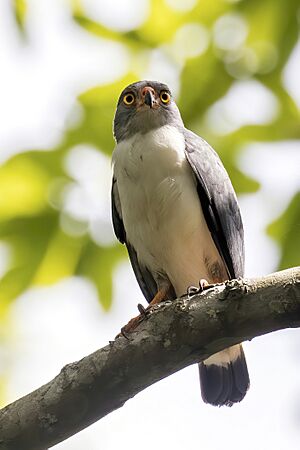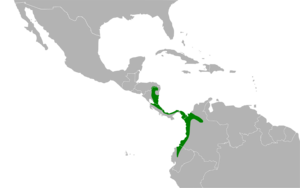Semiplumbeous hawk facts for kids
Quick facts for kids Semiplumbeous hawk |
|
|---|---|
 |
|
| A semiplumbeous hawk in Panama | |
| Conservation status | |
| Scientific classification | |
| Genus: |
Leucopternis
|
| Species: |
semiplumbeus
|
 |
|
The semiplumbeous hawk (Leucopternis semiplumbeus) is a cool bird of prey that lives in the forests of Central and South America. It's part of the Accipitridae family, which includes eagles and other hawks. You can find this special bird in countries like Colombia, Costa Rica, Ecuador, Honduras, and Panama. It loves to live in warm, wet lowland forests.
Contents
What Does It Look Like?
The semiplumbeous hawk is a small bird, usually about 30 to 33 centimeters (12 to 13 inches) long. That's about the size of a small falcon! Its back is a dark gray color, but its belly and throat are bright white.
This hawk is easy to spot because of a few special features. It has a bright orange "cere" (that's the waxy part above its beak) and a cool black mask around its eyes. Its eyes are a bright yellow, and its legs and feet are orange or reddish-orange.
How It Behaves and What It Eats
Semiplumbeous hawks are usually quiet and hard to see when they are flying. Instead, they like to sit very still on a high branch, waiting patiently for their next meal. This way of hunting is called "sit-and-wait."
These hawks often follow groups of army ants. Why? Because the ants stir up other small birds, like antbirds, which are a big part of the hawk's diet! Besides small songbirds, they might also eat bats, lizards, and even small snakes.
When it's time to find a mate, these hawks become very noisy. They make loud, high-pitched whistling sounds that go up in tone, like "kwee...wee...wee...wee...wee." When it's not breeding season, they are much quieter.
Where It Lives
You can find semiplumbeous hawks in different parts of Central and South America. They live in eastern Honduras and Nicaragua. They are also found in southern parts of western Colombia and northwest Ecuador. There have even been some recent sightings in northern Peru, which might be this hawk or a very similar new species!
These hawks prefer humid (wet) forests in tropical and lower subtropical areas. You might see them at the edges of forests, in small patches of forest, or in areas where tall new trees are growing. They usually live at elevations below 500 meters (about 1,640 feet) above sea level, but sometimes they can be found higher up, even at 1,600 meters (about 5,250 feet)!
Population and Conservation
The semiplumbeous hawk is currently listed as "Least Concern" by conservation groups. This means it's not in immediate danger of disappearing. However, its population is actually quite small, with an estimated 1,000 to 10,000 adult birds left in the world. This number is going down.
The main reason for this decline is deforestation, which means forests are being cut down. This also leads to habitat fragmentation, where the forests are broken up into smaller pieces. This makes it harder for the hawks to find food and mates.
Scientists don't know a lot about these hawks. More research is needed to understand their lives and how to best protect them.
Images for kids




